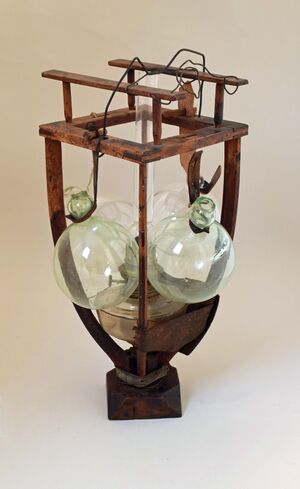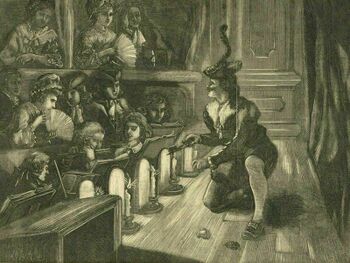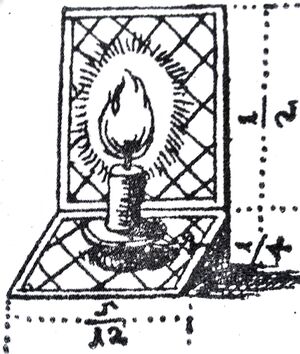Illuminating, decorative and mobile[edit]
In the Italian Renaissance courts, light was central. Feasts and festivals were illuminated with torches, candles, and displays of fireworks. The temporary indoor theatres too were lit, not just for visibility, but for the pleasure of light.
In the 16th century princely courts of Italy, light embodied the joy of living, and represented the triumph of life over death. Light displays were a feature not only of theatre performances but also of processions, dances, illuminations, and all kinds of celebratory events. Candles, torches and fireworks were used as visible sources of light, reflecting and sparkling off the shining material of costumes and decorations, as well as the clothing and jewels of those present.
In the court theatres – stages and seating built especially for the occasion – the lighting of the auditorium had the character of a festival hall, blazing with light. One description of a feast in Florence dating from 1568 describes how, when the candles in the auditorium were lit, the stage curtains were drawn aside to reveal the scene – the auditorium and the stage worked together to create the sensation of festive bliss and beauty, fused by light. Multiple cut glass and crystal chandeliers illuminated the space, and glass vessels filled with water, called bozze (Q30608), were used to concentrate the light of candles or torches. The bozze could also be filled with coloured water, giving further variation to the light.
Sebastiano Serlio, in his 1545 treatise Architettura (Q30278), describes how to light the stage. His plans show a semi-circular auditorium – like the amphitheatres of Antiquity – and a stage with a shallow, wide flat floor at the front, and a raked section behind with the perspective scene constructed on it. There was no proscenium arch.
In describing his scenes for comedy, tragedy and satire, Serlio refers to the buildings ‘adorned with innumerable lights, great, middle sized and small’ placed so as to look like brilliant precious stones – diamonds, rubies, sapphires and emeralds. He also describes the sun rising, traversing the sky, and setting, and planets going through the air. Serlio categorises three kinds of light: general stage light, decorative light, and mobile light.
The general lighting of the scene and acting space is achieved with torches, suspended in front of the stage, together with chandeliers with large candles. Above these are glass vessels filled with water and a piece of burning camphor, acting as reflectors to increase the intensity of light on the stage. It is notable that Serlio does not attempt to align the stage lighting with that of the scenery – he says the painted shadows should indicate light coming from one side, but the actual light is from above. Serlio notes this issue, but pragmatically says the light will be brightest if placed over the centre of the stage. 350 years later, Adolphe Appia (Q249) returned to this question and addressed it in his theorisation of stage lighting.
Serlio goes on to describe in detail the decorative light and how it should be arranged. Small openings in the scenery have lights behind, and these apertures have small pieces of coloured glass, colouring and diffusing the light. Most importantly, glass vessels filled with coloured water are placed between the light source and the opening. If a brighter light is required, a torch can be used instead of a candle, with a polished metal basin as a reflector. Thus Serlio anticipates the fundamentals of the modern spotlight: source, reflector and lens.
The third type of light in Serlio’s schema is for the firmament – the sun, moon and planets. He does not give details of these, but they are known from earlier accounts of Italian festivities. According to Vasari’s Life of the Artist Aristotele di San Gallo (Q30602), he had made a lantern containing two torches, which could be moved mechanically along an arch. In front of the torches was a large crystal ball, 58cm in diameter, filled with water, focusing the light. During the course of the play, the sun rose, traversed the sky, and set again at the end of the comedy – so mimicking the theatre of Antiquity, that timed its performances according to the sun.
Later, De’ Sommi in his dialogues (Q708) describes a technique in which the auditorium lights are placed not between the assembled people and the stage, but behind them, so reducing glare and giving a clearer view of the stage. In this account, De’ Sommi points to a model of stage lighting that begins to move away from the festival hall of the Renaissance, and towards the picture-box of the Baroque court theatres; the joyous atmosphere is retained, but the stage is now the primary focus.



